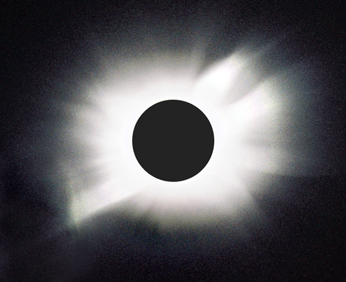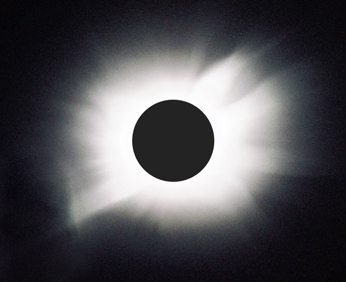 |
 |
 |
 |
 |
 |
 |
 |
CLICK on any image above to see at twice the size (and resolution).
A) Top Left: Linear display of composite
of ten (intensity scaled median) and mosaiced digitized image frames.
B) Top Right: 50% intensity of measured
median radial brightness profile subtracted from A.
C) Bottom Left: 33% opaque "unsharp
mask" of A (2 pixel FWHM Gaussian kernel, 75% peak pixel normalization)
layered on A.
D) Renormalized 50% intensity of measured median
radial brightness profile subtracted from 50% of A.
THE IMAGE CONSTRUCTION PROCESS
The above "final" image was derived from ten separate frames in an image raster as the flight deck gyro platform was offset pointed during totality. Fifteen individual images were obtained with the eclipsed sun completely, or partially, within the field of view of this camera. Three images of the 15 were rejected as they were excessively blurred due to platform motion during the exposures. Two were rejected because only a small portion of the corona was contained within the field-of-view and proved difficult to properly intensity scale due to the nature of the film digitizing process. The "input" images are shown below:

CLICK the above image above to see at twice
the size (and resolution).
The ten selected frames were color separated into R, G, and B components, and each set of color components. The images flux renormalized to a common intensity and aligned translationally and rotationally (via bi-cubic interpolation with since apodization) by simultaneous minimization of paired subtraction residuals for all images in a color set. The software used for this purpose was the same used in reducing and processing the CCD image data which is described HERE. Once flux scaled and co-registered, the image "stacks" were median collapsed, ignoring non-contribuiting pixels (i.e., parts of the image, after shifting, for which the Sun is off the frame). The three three medianed R, G, B, planes were then recombined into a composite color image.
Note: Sharp-eyed individuals will probably have noticed a double "image ghost" (afocal reflections from the aircraft window) below and to the left of the Sun in the original image frames. An attempt was made to remove this artifact in the final composite/mosaic. That process was imperfect and left a low-level uncompensated imprint of the ghost in the final images, A - D on the top of this page.